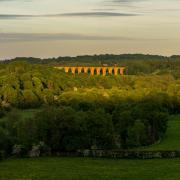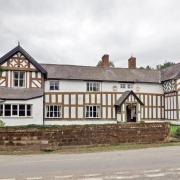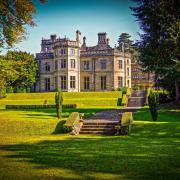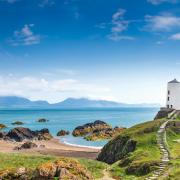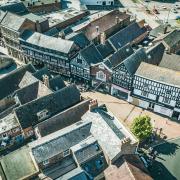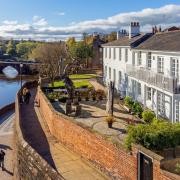Whether it’s a day at the seaside, experiencing the world’s fastest zip line, conquering Snowdon, or exploring historic castles, one way to enjoy North Wales is by train. Using a mix of the mainline network and narrow gauge and miniature steam trains, you can travel from Chester to Holyhead and Caernarfon to Porthmadog, visiting tourist attractions along the way. Nigel Howle takes a train trip to the region that’s a home away from home for the people of Cheshire.

WREXHAM
A 14-minute rail journey from Chester lies Wrexham the large market town granted city status in 2022. Many Cheshire travellers perhaps only bypass Wrexham on the way to the coast but there’s plenty to see and do for those who take a detour into town.
Residents will tell you Wrexham is on the up and they’re not just referring to the city’s historic football club, the sleeping giant that’s surprisingly being sprinkled with Hollywood stardust following its acquisition by actors Ryan Reynolds and Rob McElhenney.
Star spotting at the Turf Hotel, next to Wrexham’s historic Racecourse ground, may now have become a popular pastime, but there’s more to see and do in Wrexham if actors or football aren’t your thing.
Wrexham’s 16th-century gothic Parish Church of St Giles is the largest medieval church in Wales. Its bell tower dominates the skyline and visitors can even book a visit to climb up to the church roof for a bird’s-eye view of the town.
Ty Pawb, which translates into English as Everybody’s House, brings together art galleries, community space, a studio theatre, meeting rooms, a market hall, an extensive food court and bar. It is home to more than 30 independent local businesses.
DID YOU KNOW?
Wrexham Lager was served on the Titanic and once had an international following. The brewery, founded by two German exiles in Wrexham in 1882, was a well-known brand both worldwide and close to home until the beginning of the 20th Century.
Two world wars and the ensuing anti-German sentiment in the UK led to problems for the brand, but it rose again following a takeover by Ind Coope and Allsop and eventually became part of Carlsberg UK.
Changing brewing methods and mass market production saw Wrexham Lager overshadowed by other brands to the point that commercial production at its Wrexham birthplace stopped in 2000 and total production in the UK ceased in 2002.
Recognising the Importance of the Wrexham Lager name, brewing enthusiast and Clwyd South MP Martyn Jones negotiated to buy the brand for just £1. Now, with a new brewery in the town centre, Wrexham Lager is on the rise again.

LLANGOLLEN
Just over 10 miles from Wrexham lies Llangollen. There’s no direct rail link between the city and the picturesque town but once there you can visit one of Wales’s famous heritage railways.
The Llangollen Railway appeared to have fallen victim of Covid lockdowns when the receivers were called in. But it's now back on track, taking the prestigious Attraction of the Year accolade at the Go North Wales Tourism Awards.
A new station was opened at Corwen by the Llangollen Railway Trust following a £1.25 million investment.
The popular town beside the River Dee is a stopping-off point for walkers and climbers heading to Snowdonia, but it has much to offer anyone looking for a longer stay.
Visitors have been enjoying horse-drawn boat trips from Llangollen Wharf for more than 100 years. Motorised narrow boat trips are also available over the spectacular Pontcysyllte Aqueduct. The first 11 miles of the Llangollen Canal, including the aqueduct, have been designated a UNESCO World Heritage Site and the aqueduct is recognised internationally as a masterpiece of waterways engineering and a pioneering example of iron construction.
Llangollen offers many places to eat and to stay, including the Bridge End Hotel, the Corn Mill, the Hand Hotel, and Gales Wine Bar and Hotel.
DID YOU KNOW?
Plas Newydd House has been welcoming visitors since 1780 and was the home of the 'Ladies of Llangollen', Lady Eleanor Butler and Miss Sarah Ponsonby, two upper-class Irish women who lived together as a couple and whose relationship scandalised and fascinated their contemporaries. Tourists can walk in the footsteps of 18th-century visitors Josiah Wedgwood, William Wordsworth, and the Duke of Wellington, as the house, known for its remarkable oak-carved panels, and gardens is open to the public.

SNOWDONIA
Our train theme continues with a visit to Snowdonia and the Snowdon Mountain Railway.
From a station at Llanberis, the journey takes passengers to Hafod Eryri, the UK’s highest visitor centre, at 1,065 metres above sea level.
The journey takes around one hour each way, and the turnaround time is around half an hour.
Travellers can choose between steam or diesel trains. From the visitor centre, there’s a marked path to the summit at 1.085 metres above sea level which, on a clear day, affords views to the west as far as Ireland and north to the Lake District.
Snowdonia is a paradise for walkers and hikers but there’s a further attraction for adrenaline junkies – the world’s fastest zip line, based at Zip World, Penrhyn Quarry, near Bethesda. The attraction’s operator says daredevils can reach speeds of up to 125mph as they fly above what was once the world’s largest slate quarry.
The fortress town of Caernarfon is around 15 miles from Llanberis and is the starting point for the Welsh Highland Railway, the UK’s longest heritage railway running from beneath the castle walls to Porthmadog, along a 25-mile track.
The trains, hauled by the world's most powerful narrow gauge steam locomotives, climb from sea level to over 650ft on the foothills of Snowdon, before zig-zagging dramatically down the steep hillside to reach Beddgelert, nestling in the heart of the National Park, then through the magnificent Aberglaslyn Pass and on to Porthmadog.
Before embarking on a journey, there’s plenty to see and do in Caernarfon which is dominated by perhaps the greatest of the Welsh castles.
DID YOU KNOW?
There’s been a castle at Caernarfon since the 11th Century and work on the current stone structure began in 1283. Edward 1 and his military architect Master James of St George erected a castle, town walls and a quay all at the same time, on a grand scale.
The international significance of Caernarfon, along with nearby castles and town walls in Conway, Beaumaris, and Harlech, has been recognised with designation as a UNESCO World Heritage site.
The castle, which houses the Royal Welsh Fusiliers Museum, attracts more than 200,000 visitors a year.
SANDY SHORES
From Talacre to Black Rock Sands, the coastal towns and beaches along the Welsh Coast have an enduring popularity.

LLANDUDNO
With its Victorian grandeur, good choice of hotels, and traditional seaside attractions, Llandudno is among the jewels in the North Wales crown.
Lynette Esposito owns the multi-award-winning Elm Tree Hotel, on the town’s seafront together with her husband, Arturo.
'We have worked in hospitality for many years and when, in 2017, we wanted to buy our own hotel, we looked at a lot of towns and Llandudno ticked all the boxes,' says Lynette.
'Llandudno attracts visitors all year round as there's always things going on. Venue Cymru is a busy theatre and conference venue and hosts international snooker. Ronnie O'Sullivan has stayed here and he recently recommended the Lime Tree in an interview.
'We certainly believe we made the right decision in moving from London to Llandudno. We feel supported by the local community, our product suppliers from the area, and other hospitality businesses in towns. There's a close-knit hospitality community and we help each other.'
Among other restaurants in and around the town, Lynette recommends Snooze the tapas bar in Church Walks; Number 25, an Italian restaurant in nearby Rhos on Sea, and Bryn Williams at Porth Eirias run by the internationally acclaimed Welsh chef.
The Llandudno Victorian Extravaganza takes place on the first May Bank Holiday weekend each year; the streets are filled with Victorian fairground rides and vintage attractions during the three-day festival.
CONWY
Nearby Conwy is a walled town dominated by its magnificent castle. Visitor attractions include Aberconwy House dating back to the 14th Century which is now owned by the National Trust; Thomas Telford’s suspension bridge, which spans the River Conwy and Plas Mawr, an Elizabethan house described as the finest of its kind in Britain.
Conwy station is on the Crewe to Holyhead line, offering links to Cardiff, Birmingham, and Manchester Airport, via Warrington Bank Quay.

ANGLESEY
Anglesey, a popular destination for families from Cheshire is known for its unspoiled sandy beaches including Benllech, Trearddur Bay, Rhosneigr and Lligwy.
The Welsh tourist board describes the island a foodie paradise. It recommends restaurants including the Tavern on the Bay at Red Wharf Bay, which prides itself on using the best local produce including seasonal Welsh lamb, beef and fish; the Lobster Pot, Church Bay, which has been serving the freshest Welsh pot caught lobster and crab, mussels, oysters and scallops since 1946, and the Midland, Beaumaris. The Midland team also runs the superb Mercado butchers and deli in Beaumaris and restaurants in Conwy and Menai Bridge.
WALK THIS WAY
Walk the Snowdonia Slate Trail
The Snowdonia Slate Trail begins in Bangor, takes a circular route around the mountains and quarries, and ends at Bethesda.
It totals a marathon 83 miles, which can be completed in up to 13 sections with maps available online.
Walkers witness a stunning mix of scenery, social and industrial history, exploring a time when North Wales was the centre of the slate trade.
Towns and villages along the way include Llanberis, Capel Curig, Betsw-y-Coed, Llan Ffestiniog, and Beddgellert. The slate trail is a joy for narrow gauge railway enthusiasts, as it visits the Penrhyn Quarry Railway, Llanberis Lake Railway, Snowdon Mountain Railway, the Welsh Highland Railway and the Ffestiniog Railway.
For anyone looking to complete the route on consecutive days there are many places to stay from hotels to log cabins, and youth hostels to campsites, including the Snowdonia Parc campsite, Waunfawr, which has a micro-brewery.

SEVEN WONDERS OF WALES
An 18th-century poem talks of the Seven Wonders of Wales, and all are based in the north of the Principality.
The short rhyme reads:
Pistyll Rhaeadr and Wrexham steeple,
Snowdon's mountain without its people,
Overton yew trees, St Winefride's well,
Llangollen bridge and Gresford bells.
Pistyll Rhaeadr Falls are located four miles from the village of Llanrhaeadr-ym-Mochnant in Powys.
Wrexham steeple refers to the 130 ft tower of St Giles' Parish Church and is considered one of the finest medieval buildings in Wales.
Snowdon Mountain, the highest peak in either Wales or England, needs no explanation.
The yew trees in Overton on Dee are between 1,000 and 2,000 years old, apart from a tree planted by Queen Elizabeth II in 1992 to celebrate the 700th anniversary of Overton receiving official borough status.
St Winefride's Chapel, Holywell, dates back to at least the 12th century, when its waters gained a reputation for being able to heal all ailments.
Llangollen Bridge across the River Dee is a Grade One Listed structure. There’s been a bridge at Llangollen since the 13th Century and the current structure is thought to date back to the 16th or 17th Century,
The eight original bells of All Saints’ Church in the village of Gresford are mentioned in historical documents from 1714 and are renowned for the purity of their sound. The church is a large, impressive building with medieval stained-glass windows.




